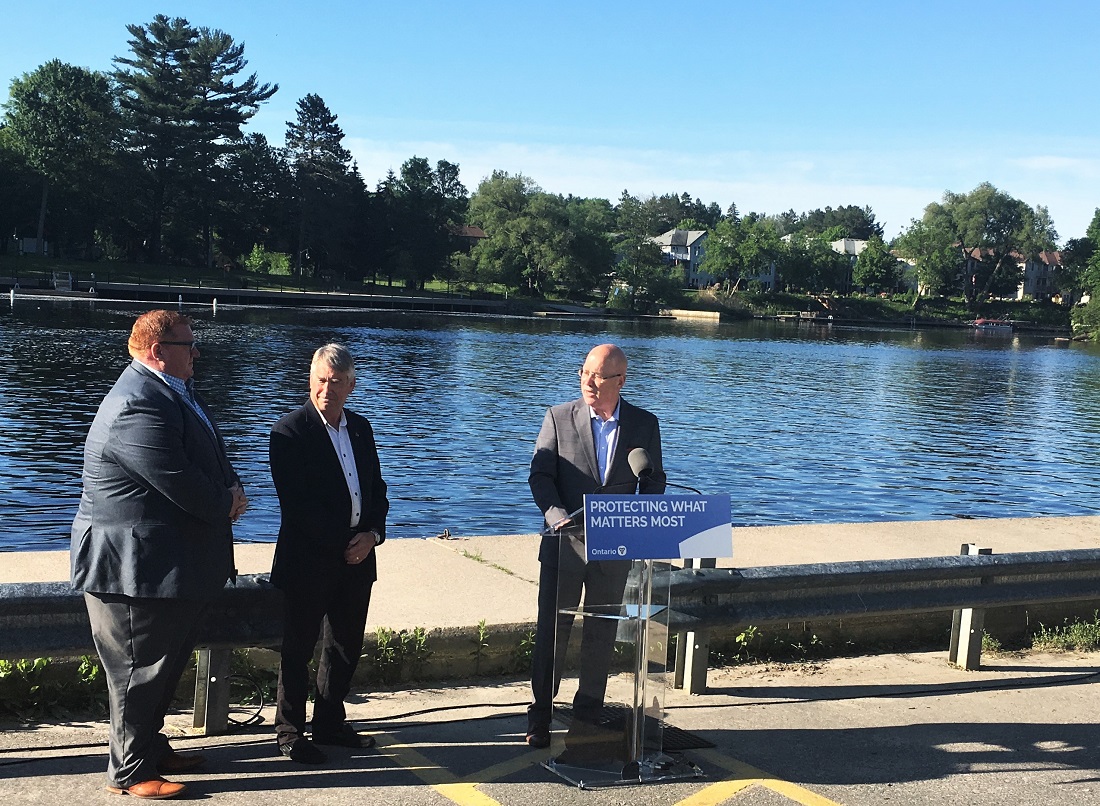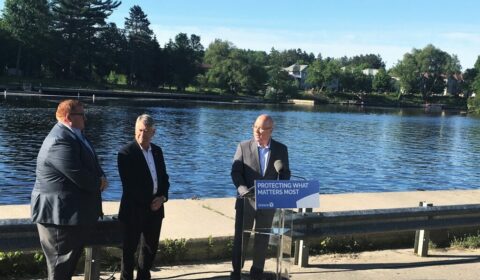TOWNS GET MORE FLOOD ASSISTANCE FROM PROVINCE
Mark Clairmont | MuskokaTODAY.com
BRACEBRIDGE — It was an ironic sight here in the parking lot beneath the Bracebridge Falls early this morning.
Muskoka mayors and provincial MPPs gathered in a sunny idyllic summer setting on the shoreline of the Muskoka River that two months ago was several feet deep in flood water and a forest of tree debris.
As photo-ops go, it was good PR, even if it didn’t get the appropriate props.
Still, with water levels down and the river a gorgeous deep dark blue, the tranquil setting belied the damage the reeling communities up and down it remain stuck with.
Behind the podium that boasted “Protecting What Matters Most,” Ontario Municipal Affairs and Housing Minister Steve Clark announced extra provincial funding for municipal infrastructure rebuilding.
The $1 million for towns and cities provincewide is meant to “protect communities from disaster” and help them “withstand extreme weather,” said an accompanying release.
That means raising roads that won’t be flooded the next time, something Bracebridge has already begun along Beaumont Drive, said Mayor Graydon Smith, who was on hand with MPP Norm Miller at 8 a.m.

As part of this pilot project, Ontario will provide municipalities that qualify for the Municipal Disaster Recovery Assistance (MDRA) funding with up to 15 per cent above the estimated cost of rebuilding damaged public infrastructure to make it more resilient to extreme weather.
Examples could include raising roads to provide better overland flow of water, improving the columns or footings of bridges, or increasing the size of ditches and catch basins to increase their capacity to hold water.
The money is on top of existing provincial funding available to affected citizens and municipalities through the Disaster Recovery Assistance for Ontarians (DRAO) fund, Clark told about two politicians, town staff and media.
DRAO is a program that can help eligible people recover costs for damage to private property from a natural event, such as a flood or tornado that causes costly and widespread damage in an area.
The money was welcomed by Smith, whose community was hardest hit as the flood waters cascaded downstream, growing in intensity and immensity in two of the worst weeks in Bracebridge’s history.
Escalating repair costs continue, as new damage is discovered every day.
So it will assist town staff, who have worked hard and done a great job of cleaning up the shoreline and other wash-out areas of town, like the Beaumont Farm area, along Santa’s Village Road and east in Fraserburg, which was an island cut off for a couple of days.
Huntsville Mayor Scott Aitchison described it as being “not like for like,” but allows towns to “enhance” and not just replace what was lost, but to build beyond existing infrastructure.
A sort of silver lining to a terribly bad situation, he agreed many Muskokans continue to contend with.
But the roads to recovery are expensive.
One Muskoka marine operator said there was “at least a billion dollars” of damage around the lakes, referring mostly to private waterfront owners.

Clark said in prepared remarks: “We want to help municipalities build back better — to flood damaged roads, bridges and other infrastructure to a higher standard, so it can better withstand extreme weather and we know that some municipalities have limited financial resources to improve local infrastructure.
“By not having to rebuild the same washed-out road or bridge again and again, communities will save money over the long-term.”
He said communities affected by flooding after March 1, 2019, are eligible.
Investments that help reduce the risk of repeated damage due to extreme weather can save municipalities, small businesses and homeowners time and money, and keep residents safer when disasters do strike, his statement said.
Local MPP Miller, who Clark lauded for his advocacy in the funding, added: “Given that we’ve had two ‘hundred-year’ floods in a few years, I am pleased that we are going to support municipalities to redesign and rebuild essential municipal infrastructure so that it will be better able to withstand future flooding.”
He said: “Our government’s Made-in-Ontario Environment Plan supports updating government policies to improve climate resilience. This is something our local mayors and I raised with the minister a few weeks ago, and minister Clark has acted quickly to make these changes to help the communities that suffered flooding in the spring.”
Smith called the investment an “opportunity to improve the quality of municipal infrastructure,” that will allow municipalities “to better manage their finances in the long term.”
Clark noted that the Insurance Bureau of Canada reported that insured damage from severe weather across Canada reached $1.9 billion in 2018.
He said: “Our government’s Made-in-Ontario Environment Plan supports updating government policies to improve climate resilience.”
He said the government established an internal task force to address risks of flooding and recently conducted an online survey to identify ways to help make our communities more resilient to flooding.
Part of that was a hastily-called meeting with local officials shortly after the flood waters began to recede.
The government’s Ministry of Natural Resources was criticized at the time for its handling of the flood before and during.
